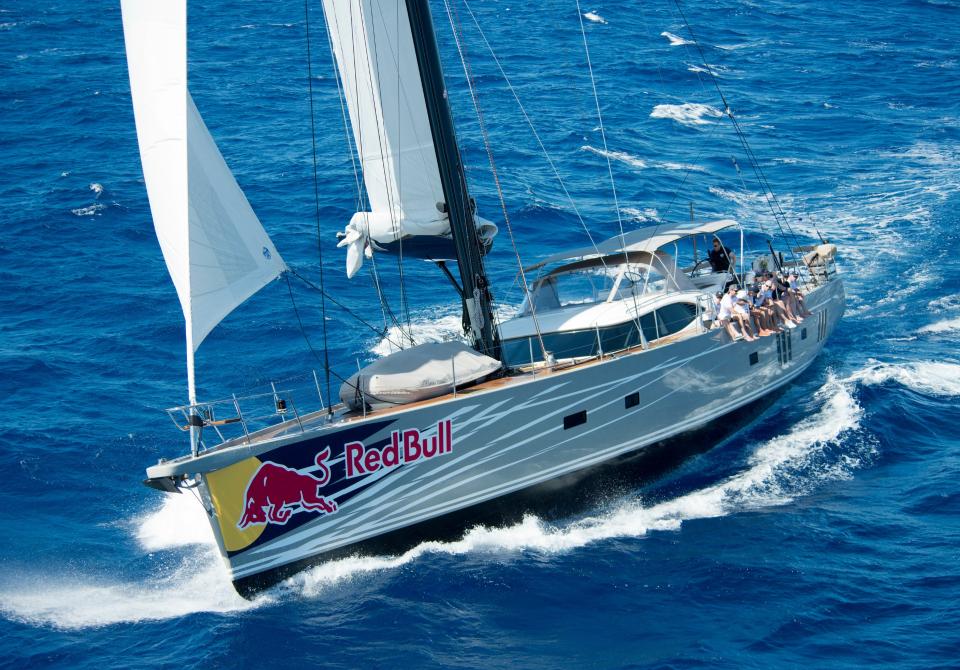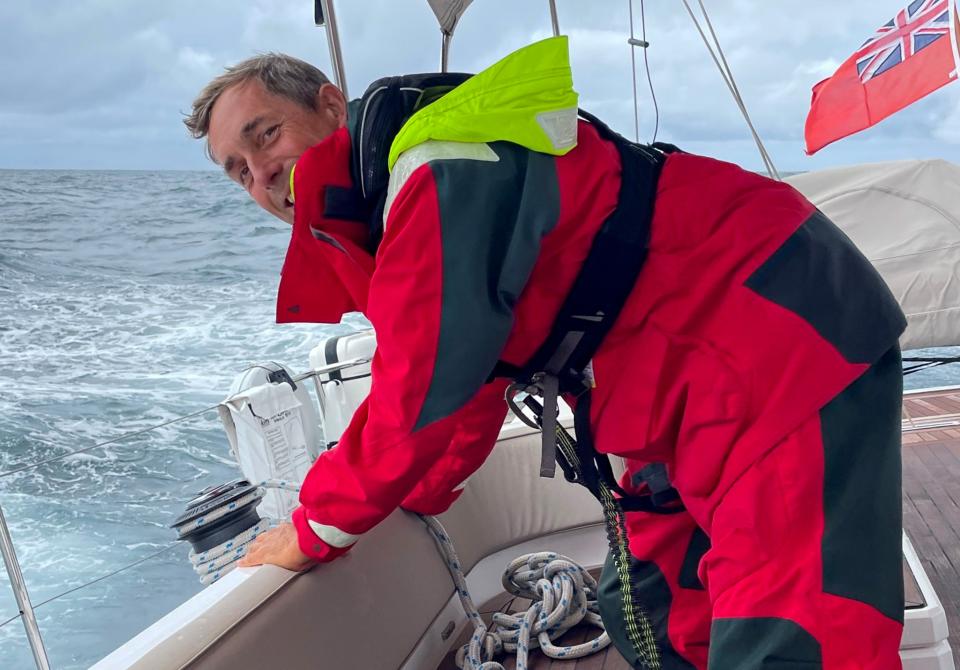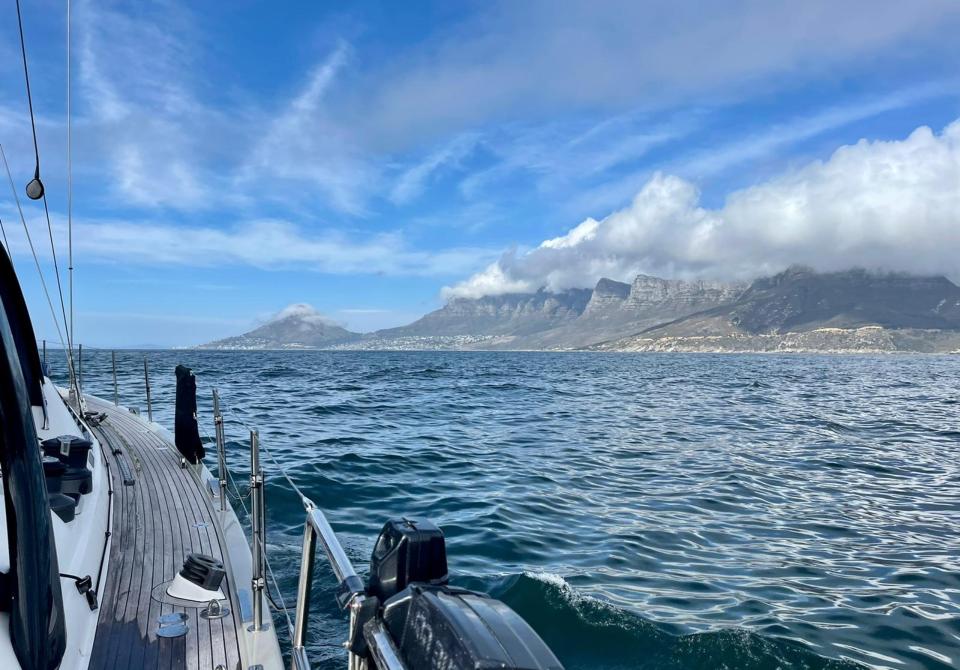It’s a highlight for any circumnavigation and it didn’t disappoint the fleet on the Oyster World Rally 2022-23.
This is the section of the Rally that demands the greatest respect and caution because it can stir up tempestuous seas. For Trevor Hill, the owner and skipper of Oyster 72 Intrepid, as for others on the 2022-23 Rally, it was a leg that saw varied, occasionally rough weather conditions and ended in an exhilarating express ride on the mighty Agulhas Current.
“We are in it now and it is driving us south, down the coast, giving us an additional 1.5 to 2.0 knots, a huge accelerant. If we're lucky, we can stay in the flow and pick up an extra knot or two. It all adds up to over 20-35 miles extra per day. Amazing!’
Hill wrote this late in 2022 while on passage between the island of Réunion and Cape Town. A former Canadian Navy officer, marine systems engineer and serial entrepreneur, Hill had been dreaming of sailing round the world for more than 20 years. In late 2021, he and his wife, Judy, left the Mediterranean to join the Oyster World Rally. A year later, and almost 20,000 miles down the track, they were tackling the most feared part of the entire circumnavigation: the passage between the island of Réunion and Cape Town.
Intrepid’s experience may not be what most sailors expect of one of the world’s most daunting ocean passages, but today it is more typical. Sailing 2,250 miles direct, or 1,430 miles to Durban followed by a further 820 miles south to Cape Town, exposes yachts to tough conditions. First, there is the open ocean, then the concentrated winds and currents at the tip of Madagascar and finally, immense forces that flank the African continent that have generated some of the largest wave heights ever recorded.
The Agulhas Current is an ocean boundary current that flows south along the coast of South Africa and to the west side of Madagascar at 4-5 knots. It spins off huge mesoscale eddies, located near the bottom of Madagascar, then pushing west. The world’s oceans all have boundary currents that freight warm water from the Equator to the Poles, helping to regulate global temperatures, but the Agulhas is unique in its concentration of colossal forces.
A gargantuan river of water, it is estimated to transport around 70 million cubic metres of water per second, rising to more than 120 million cubic metres per second as it flushes over the shallow Agulhas Bank off the southern tip of Africa. Even that is only part of the picture. As it moves south, the Agulhas Current frequently collides with the mighty low pressure systems that roll ceaselessly across the Southern Ocean.
“Where the Agulhas Current comes up against the African continent, it tends to get focussed close to the continental shelf, so it is quite a narrow band,” explains meteorologist and round the world sailor Chris Tibbs. “It is moving quickly, taking lots of warm, moist air and energy. Not very many hundreds of miles south, it meets the cold water of the Southern Ocean.
“The prevailing winds are moderate or strong north-easterly winds down the coast. But if you get a Southern Ocean low and a cold front moving into warmer water, you can get quite aggressive fronts and very strong south-westerlies. And any time you get wind against current, you get dangerous waves, big waves – wave breaking conditions.”
Paul Adamson, former COO of Oyster Yachts, made this passage from Réunion in the 2012-13 Oyster World Rally as skipper of the then Eddie Jordan’s Oyster 885, Lush. “For the Rally, it is the most taxing part, testing passage making, skippering skills and weather skills,” he says.
“When we crossed the Current, we had 30 knots from the north-east and the sea was pretty big then.”
As many crews do, Lush’s decided to cross to Durban then coast hop to Cape Town via Port Elizabeth, dodging south-westerlies before sprinting onwards in favourable winds. Adamson recalls sitting tight in Durban watching the barometer fall, rain arrive with the cold front before quickly clearing to allow them to leave.
“We wanted to make Port Elizabeth in one hit before the next south-westerly, so we left, hooked round breakwater and found the sea state was still horrendous. We pitched over a wave, fell off the back and dropped a greener over the whole boat. Another crew [still in port] said they saw our keel. So, we turned back and waited, and when we left again we were doing 19 knots over the ground with the current.”
Any time you get wind against current, you get dangerous waves, big waves – wave breaking conditions
As the weather forecaster for the Oyster World Rally for the leg to Cape Town, Chris Tibbs has minutely examined all the real time and historical data for this area. Timing a departure from Réunion is crucial and must be precise.
“This is an 8-10-day passage and with so much heat and energy, the forecast can change quickly, so we need to pick a time for people to leave on a 10-day forecast, with no cold front coming through,” he explains. “The Current narrows off South Africa, so you plan to arrive either before a front or to slow down and let it come through. The Current starts to be magnified between Richards Bay and Durban, so you look to cross it as far north as possible.”
The frequency of these fronts varies year on year, says Tibbs. “Some years there is a cold front every two weeks. Last year there was one every few days. This is one of the few areas of a round the world trip where I really would suggest people get weather routing help.”
As Head of Group Events, and director of the Oyster World Rally, Allie Smith emphasises to skippers and crews: “This is not the longest part of the Rally but it is the trickiest, so we make sure that everyone is fully supported.”
As the Rally prepared for the passage to Cape Town in November, all skippers took part in a Zoom call with Chris Tibbs and the Rally’s founder organiser, Eddie Scougall. They were given a comprehensive briefing on weather and current, and advice on the best timing for departure.
Smith says that skippers often strengthen crew numbers for this stage. “From Indonesia to South Africa, quite a few of the fleet added one person, usually family or a friend. They know they have to be prepared,” she says.
In spite of its fearsome reputation, many crews actually enjoyed this leg and found it really exciting. One of those was Julia Thomas, the skipper of Oyster 565 Adalia 2. She and her husband, James, mainly sail double-handed, and crossed the whole of the Pacific two-up, but had two extra crew for the final half of the Rally from Australia to the Caribbean.
“Everyone in the fleet was excited but nervous and there was a lot of talk about departure times and how to navigate it,” she says. “When we set off, I knew there was potential for it to be much worse, but at each point the experience matched what I thought it would be, taking into account the advice we were given.
“In fact, we had an amazing time. It was one of my favourite legs. We loved it.”
Besides taking advice from Chris Tibbs, Thomas used a personalised weather routing service provided by meteorologist Simon Rowell. “I found that very beneficial as he was looking at us as an individual boat.
“We used Simon for a good chunk of the Rally, including the whole of the Indian Ocean, and for us it was definitely a good investment. I found it very reassuring to have someone at the other end to look at the whole picture every day or twice a day, as the weather can change so quickly. There was a tremendous amount of planning and looking at weather models and how many steps we should make in the journey.”
The forecast did, in fact, change. “It was going to be very strong from the north-east with 4m seas so we decided to go to Durban. That meant we had to cross the current but, to be honest, it was nothing. We approached from the north with two knots against us and there were 2m seas, but the sea state was fine.
“From Durban, we had to wait for a weather window. We came out and had to beat for 24 hours and that was uncomfortable. Then we started to find the current and did the rest of the leg in one hop. At one point, the GPS was showing we had 6 knots of current in our favour. With the wind and waves behind us, we were flying.”
Thomas describes how she monitored the sea temperature to stay in the slender band of warm water current. “It was like hunting, in a way,” she says. “We noticed it would change by 2-3°C, and the further south we got, the stronger the current became. It was fast; our highest daily run was 249 miles. It was great fun being whooshed along and we were regularly doing 16 knots on our boat. Some got much higher speeds. [Ross Golding on Oyster 565] Infinity said they got over 20 knots at one point.
“Before we joined the Rally, the prospect [of this leg] did daunt us, as there was so much talk about it. But in reality, it was not as difficult as I thought. It is one of those times when you have to be patient and wait for the right weather.”
Oyster’s Allie Smith emphasises that this level of support is “the USP of the Rally”.
“For this passage, expert advice is vital, with 100% technical support from us. By this point, people are quite confident in their abilities and they will have formed their own opinions on what the weather is doing and expert advice will either concur or not. They can look at the models and evaluate them all. The skippers never have to worry they are going to have to make a decision on their own, they are supported seven days a week and will get all the information they need.”


